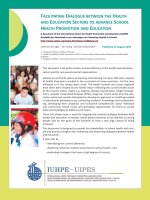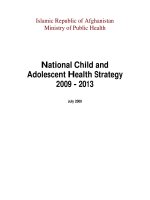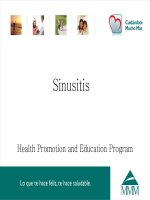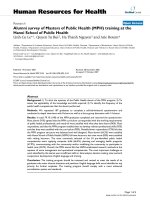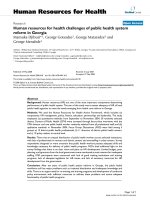Jossey Bass Publishing Dictionary Of Public Health Promotion and Education
Bạn đang xem bản rút gọn của tài liệu. Xem và tải ngay bản đầy đủ của tài liệu tại đây (2.16 MB, 187 trang )
DICTIONARY OF
PUBLIC HEALTH
PROMOTION
AND EDUCATION
Terms and Concepts
Second Edition
NAOMI N. MODESTE
T E R I S . TA M AY O S E
Foreword by Helen Hopp Marshak
Copyright © 2004 by John Wiley & Sons, Inc. All rights reserved.
Published by Jossey-Bass
A Wiley Imprint
989 Market Street, San Francisco, CA 94103-1741 www.josseybass.com
No part of this publication may be reproduced, stored in a retrieval system, or transmitted
in any form or by any means, electronic, mechanical, photocopying, recording, scanning,
or otherwise, except as permitted under Section 107 or 108 of the 1976 United States
Copyright Act, without either the prior written permission of the Publisher, or authorization through payment of the appropriate per-copy fee to the Copyright Clearance Center,
Inc., 222 Rosewood Drive, Danvers, MA 01923, 978-750-8400, fax 978-646-8700, or on
the web at www.copyright.com. Requests to the Publisher for permission should be
addressed to the Permissions Department, John Wiley & Sons, Inc., 111 River Street,
Hoboken, NJ 07030, 201-748-6011, fax 201-748-6008, e-mail:
Jossey-Bass books and products are available through most bookstores. To contact JosseyBass directly call our Customer Care Department within the U.S. at 800-956-7739, outside
the U.S. at 317-572-3986 or fax 317-572-4002.
Jossey-Bass also publishes its books in a variety of electronic formats. Some content that
appears in print may not be available in electronic books.
Library of Congress Cataloging-in-Publication Data
Dictionary of public health promotion and education : terms and concepts /
Naomi N. Modeste, Teri S. Tamayose, editors.— 2nd ed.
p. ; cm.
Rev. ed. of: Dictionary of public health promotion and education /
Naomi N. Modeste. c1996.
Includes bibliographical references and index.
ISBN 0-7879-6919-2 (alk. paper)
1. Health education—Dictionaries. 2. Health promotion—Dictionaries.
3. Health education—Societies, etc.—Directories. 4. Health promotion—Societies, etc.—
Directories.
[DNLM: 1. Health Education—Dictionary—English. 2. Health Education—
Directory. 3. Health Promotion—Dictionary—English. 4. Health Promotion—
Directory. 5. Public Health Practice—Dictionary—English. 6. Public Health
Practice—Directory. WA 13 D5535 2004] I. Modeste, Naomi N. II. Tamayose,
Teri S., 1960- III. Modeste, Naomi N. Dictionary of public health promotion
and education.
RA440.5.M634 2004
613'.03—dc22
2004013525
Printed in the United States of America
PB Printing
10 9 8 7 6 5 4 3 2 1
SECOND EDITION
CONTENTS
Foreword
vii
Helen Hopp Marshak
Acknowledgments
ix
Introduction
xi
Part One: Terms
Part Two: Health and Professional Organizations
1
133
References
161
Recommended Reading
171
About the Authors
177
v
FOREWORD
Helen Hopp Marshak
T
his dictionary was developed for professionals in the field of health
promotion and health education and in related professions. It identifies a wide range of terms and health and professional organizations commonly used by health educators and public health professionals, although
it is not meant to be exhaustive. The contents reflect the process of health
promotion and education rather than disease-specific terminology. Key
terms used in related public health disciplines, such as epidemiology, health
administration, biostatistics, environmental health, and behavioral sciences,
were included because health educators are ordinarily expected to be familiar with these areas in their practice. Terms relevant to the four settings of
health promotion and education—community, workplace, primary care,
and school—are emphasized.
This dictionary was originally prompted by our graduate students’
request for a reference list of terms that they could understand and employ
consistently in their professional reading and writing. Conversations with
other health educators confirmed the need for such a guide. The first edition
has been used by public health professionals in both academic and practice
settings and has proved to be a valuable resource for arriving at a common
understanding of terms frequently encountered by health educators.
This second edition expands on the core health education terminology
presented in the first edition. Emphasis was placed on delineating terms
related to theories and models commonly used by health educators, including planning and evaluation models, as well as key methods and strategies
vii
used by health educators that define the scope and nature of the profession.
Newly emerging areas, such as health informatics and computer-assisted
instruction, are also included.
Although it is impossible to present definitions that everyone will agree
with, every attempt was made to cross-reference terms with a wide variety
of key sources in health education. The references cited in the text and listed
at the end of this guide were used as resource materials for deciding on definitions. Suggestions for further reading follow the References.
It is hoped that this expanded guide will be useful to professionals in
health promotion and education and their colleagues.
viii
Foreword
ACKNOWLEDGMENTS
T
his book grew out of concerns shared by a number of our graduate students for a list of terms that can be used as a quick reference guide.
The reports of the 1990 and 2000 Joint Committee on Health Education
Terminology provided additional motivation for this work.
We wish to thank Helen Hopp Marshak, a colleague in the Department
of Health Promotion and Education, Loma Linda University, School of
Public Health, for writing the Foreword, sharing resources, and giving valuable suggestions for several entries.
We also acknowledge the help of the individuals who reviewed the
manuscript and made suggestions and corrections, particularly Joyce W.
Hopp, Tom Schiff, Larry Olsen, and Brick Lancaster. Finally, recognition
goes to editor Andy Pasternack and his associates at Jossey-Bass for their
valuable suggestions, encouragement, and support throughout this project.
We take responsibility for any weaknesses or omissions.
ix
INTRODUCTION
T
his dictionary provides definitions of terms and concepts frequently
used in public health promotion and health education, written in a
manner that can be easily comprehended. Many of us in the field of health
education have learned a great deal about significant health-related concepts but use terminology that is not necessarily found in any one text. This
work is an attempt to bring together a number of these terms under one
cover for easy access.
Our intent was to include the terms most widely used by a large number of people in the various disciplines of public health, particularly health
education and promotion, and also to include terms from related disciplines
with which health educators need to be familiar.
Many books and journal articles, especially more recent articles, have
been searched for new terms that appeared since the first edition of this book.
These terms, along with most of those featured in the first edition, have been
brought together, defined, and arranged in a dictionary format. Our objective is that anyone who uses this resource, whether student or health professional, will be able to look up a definition without wading through scores of
pages of books and journal articles. No attempt, however, was made to
include all of the terms ordinarily used, and we made a particular effort
to exclude disease-specific terms; so this work is by no means exhaustive. It
was not an easy task to select which resources to include as references and
which to omit, as the same terms were referenced by multiple authors. Some
important references may have been unintentionally omitted.
xi
The definitions vary in length, as is to be expected given that some
terms are simpler and more easily defined while others call for more detail
and perhaps even examples. Many entries have been cross-referenced to
show how they relate to one another.
Some terms might not meet strict health education and health promotion definitions, but keep in mind that health education relies on many
other disciplines, including epidemiology, environmental health, behavioral
sciences, and theories of learning.
This dictionary can be used as a companion to health education texts
and courses of study by both undergraduate and graduate students, as well
as in their preparation for the CHES examination. It can also serve as a
source of reference for practicing health educators, faculty, and other health
professionals involved in health education and promotion.
The dictionary is divided into two parts. Part One lists the selected
terms alphabetically. This style was chosen because it provides a simple
method of finding the entries and reflects the style of most dictionaries. If
you wish to look up bioterrorism, for example, you’ll find it under B. If you
want to find a definition for comprehensive health education or community
health, turn to C and look for them alphabetically. Do not become frustrated if a term you are searching for is not included; although many new
terms have been included, as stated previously, it is not the purpose of this
dictionary to include all the terms that you might find appropriate to health
education and promotion.
Part Two lists, in alphabetical order, several professional and voluntary
health organizations and agencies of which students and practicing health
educators need to be aware. Like the list of terms in Part One, this section
is not exhaustive. Key organizations are listed, including mailing addresses
and Web sites where information can be acquired.
A major objective in compiling this book was to keep it financially
accessible to students while at the same time including sufficient terminology and associations for organizations to improve health education information and promote health literacy.
xii
Introduction
Dictionary of Public Health
Promotion and Education
PART ONE
Terms
A
Abstinence
Refraining from the use of drugs, alcohol, tobacco, and other substances or
habits that tend to harm the body. May also refer to refusing to engage in
sex behaviors that may put individuals at risk for early pregnancy or diseases such as HIV/AIDS and other sexually transmitted infections (STIs).
Abstinence Violation Effect (AVE)
Part of Marlatt and Gordon’s 1985 model of the relapse process involving a
cognitive-emotional reaction that includes (a) guilt from relapsing and engaging in an undesired behavior (e.g., smoking) after quitting smoking or changing the behavior (e.g., smoking cessation), which is discrepant from the new
self-image (e.g., a nonsmoker); and (b) an attribution that the relapse episode
was due to personal weakness. This usually results in perceptions of decreased
self-efficacy in considering readopting a desired health behavior (Cormier,
2002; Parks, Anderson, & Marlatt, 2001; Shiffman et al., 1996). In addition to
smoking, AVE can be experienced among binge eaters (Grilo & Shiffman,
1994) and people with other addictive disorders. See Relapse Prevention.
Access to Health Care
The ease with which individuals or groups of people obtain health care or
health services in a given community. Individuals with reliable health insurance, a regular provider for health care, and higher income may have easier access to quality health care, because of their ability to pay for service,
while those with inadequate health insurance and low socioeconomic status may have limited access to health care (Bodenheimer, & Grumbach,
2002; McKenzie, Pinger, & Kotecki, 2002; U.S. Department of Health and
Human Services, 2000). Health educators look at access to health care in
terms of transportation, location of facility, hours of operation, cost and
3
financing (including health insurance), and social, ethnic, language, and
geographical concerns that may help or hinder individuals in obtaining
health care.
Accreditation
A process carried out by educational and medical institutions and organizations for quality assurance. Accreditation attempts to ensure quality of
care in medical facilities such as hospitals, and academic quality in educational institutions such as colleges and universities. The process is conducted
by an external accrediting body and is based on predetermined standards
to certify that the requirements for academic or health care excellence are
met either permanently or for a period of time.
Acculturation
The process of making modifications in one’s own culture to incorporate
behavior patterns, traits, or new ideas from another culture. Acculturation
takes place when a person moves to a new culture and is being socialized
into that culture.
Action Plan
A list of detailed steps to be taken to accomplish a specific goal, followed
by an outline or timetable designed to accomplish each step listed. See
Timeline.
Administrative Assessment
A review of prevailing policies, resources, and circumstances in communities or organizations to determine which of them help or hinder the development of a health promotion and education program. The procedure
includes resource assessment, setting a timetable for activities, and budgeting (Green & Kreuter, 1999). It focuses on the assignment of the resources
and responsibilities for implementing and evaluating the proposed program
or project.
4
Dictionary of Public Health Promotion and Education
Adverse Health Effect
Any change in body function resulting from unsafe levels of exposure to
substances such as chemicals or pollutants in the environment that can be
detrimental to human health or might lead to disease or some type of
health problem.
Affective Domain
A category for classifying learning objectives that emphasize feeling and
emotion, from the simplest outcomes to the most complex: personal interests, attitudes, values, appreciation, and methods of adjustment. Knowledge
is more effective in shaping health-related behavior when combined with
affective associations (Anderson & Krathwohl, 2001; Butler, 2000).
Example: (learning objective stated in the affective domain) “By the end of
this session, the student will be able to verbalize personal feelings about taking medication for hypertension.”
Affective Learning
Learning associated with beliefs, self-worth, appreciations, and values during which learners are emotionally and actively involved in the learning
experience and in relating to others. It can be opposed to cognitive learning (Himsl & Lambert, 1993). See Affective Domain and Cognitive Learning.
Agent
An organism or object that transmits disease from the environment to the
host or from one person to another. “The cause of the disease or health
problem, the factor that must be present in order for the disease to occur”
(McKenzie, Pinger, & Kotecki, 2002, p. 595). In health education and promotion, the term may also be applied to persons such as village and community health workers, community elders, teachers, and health educators
who communicate health messages or act as channels through which ideas
and innovations are transmitted to potential consumers. See Host.
Terms
5
Examples: The human immunodeficiency virus (HIV), which causes
acquired immunodeficiency syndrome (AIDS); the tick that carries the
virus for Colorado tick fever; and the mosquito that carries the infection
for malaria are all etiological agents.
Air Pollution
The contamination of air by pollutants (smoke, ash, dust, pollen, acid condensates, etc.), including carcinogenic substances that cause discomfort to
people and can be hazardous to health when breathed.
Alma Ata Declaration
A statement released by the World Health Assembly at the International
Conference of Primary Health Care meeting in Alma Ata, Kazakh Soviet
Socialist Republic (now Kazakhstan), on September 12, 1978. Its aim was to
commit all member countries of the World Health Organization (WHO)
to the incorporation of lifestyle and behavioral factors and improvement
of the environment into the principles of health for all by the year 2000.
Primary health care was the principal thrust of the declaration, but it also
incorporated community participation in an effort to protect and promote
the health of all the people of the world (Bunton & Macdonald, 1992). The
declaration affirmed that health is a fundamental human right that should
be made attainable for all people and that individuals have a right to participate in planning their health care.
At-Risk Groups
Groups or populations who, due to certain common existing economic,
social, and environmental factors or behavioral characteristics, may be
prone to a certain disease or condition.
Examples: Coal miners or coal workers; parenteral drug users; homosexu-
als and heterosexuals with multiple partners; employees in a clinical laboratory; persons practicing anal intercourse
6
Dictionary of Public Health Promotion and Education
Attitudes
Favorable or unfavorable evaluative reactions or dispositions toward a situation, a person, or a group, as expressed in one’s beliefs, feelings, or behavior (Rajecki, 1990). An attitude that a person holds toward hypertension,
for example, will influence behavior intentions with respect to the problem.
Example: “I like high-fat foods.”
Because attitudes may be either positive or negative, there are times
when helping people change attitudes is as important as helping them
change behavior.
Terms
7
B
Baseline Measures
Data collected prior to a program implementation and used for comparing
measures before and after the program to determine the effectiveness of the
program or new intervention.
Example: Blood pressure measurements may be taken at a specific time
(baseline); then a program of exercise and nutrition is implemented, and
blood pressure measurements are taken again about six weeks into the program and compared with the baseline measurements to determine if the
intervention is effective.
Behavior
Any observable response to a stimulus or an action that has a “specific frequency, duration and purpose, whether conscious or unconscious” (Green &
Kreuter, 1999, p. 503). Internal responses such as thinking or feeling may
be inferred from observable behavior.
Behavior may also refer to how people react with one another as well
as their environment and can be considered as a product of heredity, culture, and environment. Behavior can be both positive (beneficial) and negative (harmful). Health educators encourage positive behaviors (U.S.
Department of Health and Human Services, 2000).
Examples: Mothers in a given community breast-feed their babies from
birth through the first six months without introducing other foods and liquids, Carolyn exercises thirty minutes a day five times a week to maintain
her weight.
Behavior Modification
One of the major approaches to learning and behavior change in health
education, based on principles of respondent and operant learning, involv-
8
ing changing an individual’s response by manipulating the environment—
specifically, stimuli of a behavior or reinforcement of a behavior. Behavior
modification may also be considered a coping strategy.
Behavior modification uses the following approach (Martin & Pear,
1992):
1.
2.
3.
4.
5.
6.
7.
Identify the problem.
Describe the problem in behavioral terms.
Select target behaviors that are measurable.
Identify antecedents and consequences of the behavior.
Formulate behavioral objectives.
Devise and implement a behavioral change program.
Plan and execute an evaluation program.
Example: Using the behavior modification approach to reduce overeating
would involve the following steps. First, specify the behavioral goal or goals:
Reducing the number of snacks or amount of food eaten throughout the day.
Second, observe and record the target behavior: Keep a count of the number
of times food is eaten during a twenty-four-hour period or a food diary
recording types and amount of food eaten at each meal. Third, identify what
cues the problem behavior and attempt to alter these stimuli: If overeating
while watching television, avoid eating while watching television. Fourth,
identify and substitute new thoughts and behaviors for old, undesirable eating habits. Fifth, identify and alter reinforcers for overeating. Sixth, evaluate
behavior modification strategies, reward yourself, and if necessary move on
to another behavior problem. Recent applications of behavior modification
have added the additional step of relapse prevention strategies for encouraging people to maintain their desirable behavior changes (Foreyt, Goodrick,
Reeves, & Raynaud, 1993; Marcus et al., 2000; Shiffman et al., 1996).
Behavioral Diagnosis
Systematic analysis and delineation of specific health-related behavioral
problems that can likely affect the outcome of a health program, based on
the PRECEDE/PROCEED Model of health education program planning
Terms
9
(Chiang, Huang, & Lu, 2003; Green & Kreuter, 1999). See PRECEDE/
PROCEED Model.
Behavioral Epidemiology
The study of individual health-related behaviors and habits in relation to
health outcomes, taking into account the role of individual behavior in
causing and maintaining disease. Also includes health promotion and disease prevention research and evaluation focusing on health behaviors
(Catania & Dolcini, 2002; Owen & Crawford, 2001; Sallis, Owen, &
Fotheringham, 2000).
Example: An examination of smoking behavior and later health outcomes,
such as the incidence of lung cancer
Behavioral Health
The promotion of health by emphasizing the role behavior plays in achieving or maintaining health. Also involves the application of behavioral and
biomedical science knowledge and techniques through a variety of activities to maintain health and prevent disease (Kaplan, 1990). Behavioral
health is relevant to health education and focuses on promoting health
among people who are currently healthy.
Behavioral Health Care Services
Health services provided to people with mental health and substance abuse
problems, emotional and behavioral health disorders, and addictions.
Behavioral Intention
The likelihood that a person will engage in a given behavior, based on the
attitudes and subjective norms held by the person (Farley & Stasson, 2003;
Masalu & Åstrøm, 2003; ÅRajecki, 1990; Schwarzer & Renner, 2000).
Originally derived from the theory of reasoned action, which later became
the theory of planned behavior (Ajzen, 1991).
10
Dictionary of Public Health Promotion and Education
To predict whether or not a person will perform a certain action, you can
simply ask the person. A more precise measure of likelihood may be obtained
by asking the person to indicate his or her probability of carrying out the
action. See Theory of Planned Behavior and Theory of Reasoned Action.
Example: An individual may be asked to indicate the likelihood that he or
she might abstain from sex within the next year, as follows:
I intend to abstain from sex within the next year.
Likely ___|___|___|___|___|___|___ Unlikely
Or the person may be asked to estimate the likelihood of his or her abstaining from sex within the next year in percentage points:
There is a ____ percent chance that I will not have sex within the next year.
Behavioral Medicine
Behavioral science knowledge and techniques that are relevant to the understanding of physical health and illness and the application of this knowledge
and these techniques to prevention and treatment, as well as rehabilitation.
Behavioral medicine is concerned with various issues that may influence
health and illness, including the environment in which one lives, socioeconomic status, family dynamics, and other social factors (Gonder-Frederick,
Cox, & Ritterband, 2002; Keefe, Buffington, Studts, & Rumble, 2002; Pruitt,
Klapow, Epping-Jordon, & Dresselhaus, 1998; Whitfield, Weidner, Clark, &
Anderson, 2002).
Behavioral Objective
A statement describing precisely what the learner will be doing as a result
of a learning experience, expressed in measurable terms. Also called a performance, educational, or learner objective.
Example: “By the end of the program, 60 percent of seminar participants
will commit themselves to establishing a smoke-free environment at their
workplace within six months.”
Terms
11
Belief
A proposition or statement emotionally or intellectually accepted as true
by a person or group.
Benchmarking
Evaluating and measuring performance by comparing programs, organizations, or systems to similar programs, organizations, or systems as part
of continuous quality improvement.
Biofeedback
A therapeutic method or technique used to increase awareness of a person’s
own physiology. On the basis of feedback from the body, one may be able
to control physiological processes such as blood pressure or stress symptoms. Small changes in visual and auditory signals are used to make a person aware of bodily processes of which he or she was previously unaware,
and the person eventually learns to control the biological system on the
basis of this information (Hermann, Blanchard, & Flor, 1997).
Biofeedback focuses on the biological systems that are beyond conscious control but are acting in a way that impairs the individual’s performance, thereby contributing to stress-related diseases. In the biofeedback
process, the individual first becomes aware of any faulty response, then is
guided by the feedback signal to control the response, and learns to transfer
this control to everyday situations.
Biofeedback is used to teach people how to relax in stress management
programs and for the control of hypertension, anxiety, insomnia, and other
stress-related disorders (Kaplan, Sallis, & Patterson, 1993).
Bioinformatics
The application of statistical and computer technology to store, retrieve,
and analyze biological and health data for research and the improvement
of health and behavioral sciences (Hunter, 2004; Watanabe, 2004). The
National Institutes of Health Bioinformatics Definition Committee (2000),
chaired by Michael Huerta, released the following definition: “Research,
12
Dictionary of Public Health Promotion and Education
development, or application of computational tools and approaches
for expanding the use of biological, medical, behavioral, or health data,
including those to acquire, store, organize, archive, analyze, or visualize such
data” (p. 1).
Biological Monitoring
The constant surveillance or measuring of chemical or biological substances
in water, air, and soil for quality and characteristics or agents that may cause
serious injury or death within populations. Also, testing blood, hair, breath,
or urine to determine if individuals were adversely exposed to substances
such as lead.
Biomedical Science
Science concerned with human (or animal) biology and disease, along with
prevention, diagnosis, and treatment of disease.
Bioterrorism
The unlawful release of toxic agents or biological agents such as bacteria or
viruses into the environment (including food and water) that can adversely
affect humans, animals, or plants, with the intent of harming people.
Block Grant
Financial aid received by state governments from the federal government
to assist cities and counties in community development, social services,
education, and health. An example is the Preventive Health and Health
Services Block Grant administered by the Centers for Disease Control and
Prevention (CDC), which provides federal funding to all fifty states and to
U.S. territories for combating chronic diseases and for health education and
prevention services.
The federal government has used block grants as incentives to help the
states and counties develop health services in a variety of programs, such
as tuberculosis control, dental health, mental health, home health, maternal and child health, primary care, and alcohol and drug abuse prevention.
Terms
13
Features distinguishing block grants from other forms of federal assistance include authorizing of funds for a wide range of activities within
broadly defined functional areas; giving recipient states discretion in identifying problems, designing programs, and allocating resources; and minimizing administration in financial reporting, planning, and other federal
requirements. Block grants afford recipients a degree of financial security.
Brainstorming
A technique used in a group situation to generate as many ideas about a
particular question, topic, or problem as possible in a given (usually brief)
period of time. Group members are encouraged to express their thoughts
spontaneously, postponing evaluation and criticism of ideas until after the
brainstorming session is over.
14
Dictionary of Public Health Promotion and Education


